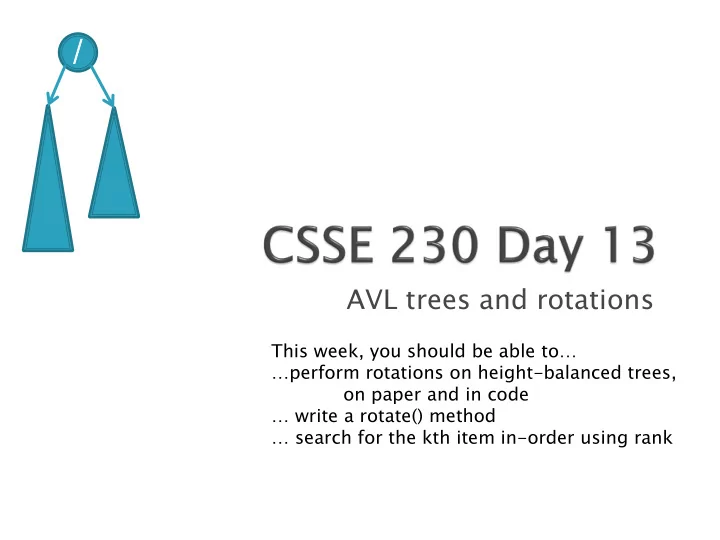

/ AVL trees and rotations This week, you should be able to… …perform rotations on height -balanced trees, on paper and in code … write a rotate() method … search for the kth item in-order using rank
Tests back later Mini-test next class See schedule page
Q1 Q1 Total time to do insert/delete = Time to find the correct place to insert = O(height) ◦ + time to detect an imbalance ◦ + time to correct the imbalance ◦ If don’t bother with balance: If try to keep perfect balance: Height is O(log n) BUT … ◦ But maintaining perfect balance is O(n) ◦ Height-balanced trees are still O(log n) For T with height h, N(T) ≤ Fib(h+3) – 1 ◦ So H < 1.44 log (N+2) – 1.328 * ◦ AVL (Adelson-Velskii and Landis) trees maintain height-balance using rotations Are rotations O(log n)? We’ll see…
Q2 Q2 = / \ or or or or Different representations for / = \ : Just two bits in a low-level language Enum in a higher-level language
Q3 Q3 / Assume tree is height-balanced before insertion Insert as usual for a BST Move up from the newly inserted node to the lowest “unbalanced” node (if any) ◦ Use the balanc ance code e to detect unbalance - how? ◦ Why is this O(log n)? We move up the tree to the root in worst case, NOT recursing into subtrees to calculate heights Do an appropriate rotation (see next slides) to balance the sub-tree rooted at this unbalanced node
For example, a single left rotation :
Two basic cases ◦ “See saw” case: Too-tall sub-tree is on the outside So tip the see saw so it’s level ◦ “Suck in your gut” case: Too-tall sub-tree is in the middle Pull its root up a level
Q4-5 Q4 Unbalanced node Middle sub-tree attaches to lower node of the “see saw” Diagr gram ams are from m Data a Structure uctures by E.M. M. Rein ingol gold and d W.J. . Hansen nsen
Q6-7 Q6 Unbalanced node Pulled up Split between the nodes pushed down Weiss calls this “right - left double rotation”
Q8 Q8 Write the method: static BalancedBinaryNode singleRotateLeft ( BalancedBinaryNode parent, /* A */ BalancedBinaryNode child /* B */ ) { } Returns a reference to the new root of this subtree. Don’t forget to set the balanceCode fields of the nodes.
Write the method: BalancedBinaryNode doubleRotateRight ( BalancedBinaryNode parent, /* A */ BalancedBinaryNode child, /* C */ BalancedBinaryNode grandChild /* B */ ) { } Returns a reference to the new root of this subtree. Rotation is mirror image of double rotation from an earlier slide
Q9,Q1 Q1,Q10 ,Q10-11 11 If you have to rotate after insertion, you can stop moving up the tree: ◦ Both kinds of rotation leave height the same as before the insertion! Is insertion plus rotation cost really O(log N)? Insertion/deletion in AVL Tree: O(log n) Find the imbalance point (if any): O(log n) Single or double rotation: O(1) (looking ahead) for deletion, may have to do O(log N) rotations Total work: O(log n)
Like BST, except: 1. Keep height-balanced 2. Insertion/deletion by index, not by comparing elements. So not sorted
EditorTree et = new EditorTree() et.add (‘a’) // append to end et.add (‘b’) // same et.add (‘c’) // same. Rebalance! et.add (‘d’, 2) // where does it go? et.add (‘e’) et.add (‘f’, 3) Notice the tree is height-balanced (so height = O(log n) ), but not a BST
Gives the in-order position of this node within its own subtree 0-based ◦ i.e., the size of its left subtree indexing How would we do findK th ? Insert and delete start similarly
Read the specification and check out the starting code Milestone 1 due soon. Get started before next class!
Goals ◦ Runtime of code with loops, including divide and conquer (cut in half = logs) Big-Oh and cousins ◦ Using common ADTs Difference between sets and maps, hash and tree implementations Decisions about which ADT is best to use for a given problem For correctness and efficiency Nice job with PurgeableStack Overall a good start!
Consider an arbitrary method named foo() foo() If base case, return the appropriate value ◦ 1. Compute a value for the node ◦ 2. Call left.foo() ◦ 3. Call right.foo() ◦ Combine the results and return them This is O(n) if the computation on the node is constant-time When searching in a BST, you only need to recurse left or right, so it is O(height) If you submitted HW4, you will receive a solution in your repo. HW5 is very relevant - I encourage you to start before the test! Let’s discuss now
Recommend
More recommend